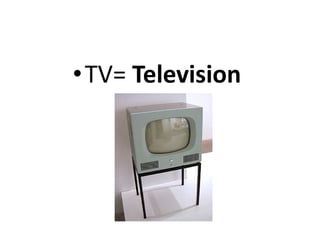
T vn radio_timebased2012nov
- 2. • Television (TV) is a telecommunication medium for transmitting and receiving moving images that can be monochrome (black-and-white) or colored, with or without accompanying sound. "Television" may also refer specifically to a television set, television programming, ortelevision transmission.
- 3. • The etymology of the word has a mixed Latin and Greek origin, meaning "far sight": Greek tele, far, and Latin visio, sight (fromvideo, vis- to see, or to view in the first person).
- 4. • Commercially available since the late 1920s, the television set has become commonplace in homes, businesses and institutions, particularly as a vehicle for advertising, a source of entertainment, and news.
- 5. • Since the 1950s, television has been the main medium for molding public opinion
- 6. • Since the 1970s the availability of video cassettes, laserdiscs, DVDs and now Blu-ray Discs, have resulted in the television set frequently being used for viewing recorded as well as broadcast material.
- 7. • In recent years Internet television has seen the rise of television available via the Internet, e.g. iPlayer and Hulu.
- 8. • The history of television records the work of numerous engineers and inventors in several countries over many decades.
- 9. • In its early stages of development, television employed a combination of optical, mechanical and electronic technologies to capture, transmit and display a visual image.
- 10. • The late 1920s, however, those employing only optical and electronic technologies were being explored.
- 11. • All modern television systems relied on the latter, although the knowledge gained from the work on electromechanical systems was crucial in the development of fully electronic television.
- 12. • The fundamental principles of television were initially developed using electromechanical methods to scan, transmit and reproduce an image.
- 13. • As electronic camera and display tubes were perfected, electromechanical television gave way to all-electronic broadcast television systems in nearly all applications.
- 14. • ^ a b Diggs-Brown, Barbara (2011) Strategic Public Relations: Audience Focused Practice p.48 • ^ Television Frequency Table, CSGNetwork.com., a Division of Computer Support Group. • ^ Study Finds Link Between Television Viewing And Attention Problems In Childrenretrieved 19 July 2012 • ^ "Paul Nipkow". Bairdtelevision.com. Retrieved 2012-11-02. • ^ "Paul Nipkow and John Baird: The Inventors of the Mechanical Television". Juliantrubin.com. Retrieved 2012-11-02. • ^ "History of the Cathode Ray Tube". About.com. Retrieved 4 October 2009. • ^ "World Analogue Television Standards and Waveforms – section – Timeline". Histrorical television data 2011. Retrieved 29 January 2011. • ^ R. W. Burns, John Logie Baird: television pioneer, IET, 2000 ISBN 0-85296- 797-7 pp. 73, 88
- 15. Radio
- 16. • Radio is the transmission of signals through free space by electromagnetic radiation of a frequency significantly below that of visible light, in the radio frequency range, from about 3 kHz to 300 GHz.These waves are called radio waves. Electromagnetic radiation travels by means of oscillating electromagnetic fields that pass through the air and thevacuum of space.
- 17. • Information, such as sound, is carried by systematically changing (modulating) some property of the radiated waves, such as their amplitude, frequency, phase, or pulse width. When radio waves strike an electrical conductor, the oscillating fields induce an alternating current in the conductor. The information in the waves can be extracted and transformed back into its original form.
- 18. • The etymology of "radio" or "radiotelegraphy" reveals that it was called "wireless telegraphy," which was shortened to "wireless" in Britain.
- 19. • The prefix radio- in the sense of wireless transmission, was first recorded in the word radioconductor, a description provided by the French physicist Édouard Branly in 1897. It is based on the verb to radiate (in Latin "radius" means "spoke of a wheel, beam of light, ray").
- 20. • he word "radio" also appears in a 1907 article by Lee De Forest.
- 21. • It was adopted by the United States Navy in 1912, to distinguish radio from several other "wireless" communication technologies in use at the time, such as the photophone.
- 22. • The term became common by the time of the first commercial broadcasts in the United States in the 1920s. (The noun "broadcasting" itself came from an agricultural term, meaning "scattering seeds widely.")
- 23. • Each system contains a transmitter. This consists of a source of electrical energy, producing alternating current of a desired frequency of oscillation.
- 24. • An antenna (or aerial) is an electrical device which converts electric currents into radio waves, and vice versa. It is usually used with a radio transmitter or radio receiver.
- 25. • Early uses were maritime, for sending telegraphic messages using Morse code between ships and land.
- 26. • The earliest users included the Japanese Navy scouting the Russian fleet during the Battle of Tsushima in 1905.
- 27. • One of the most memorable uses of marine telegraphy was during the sinking of the RMS Titanic in 1912, including communications between operators on the sinking ship and nearby vessels, and communications to shore stations listing the survivors.
- 28. • AM radio uses amplitude modulation, in which the amplitude of the transmitted signal is made proportional to the sound amplitude captured (transduced) by the microphone, while the transmitted frequency remains unchanged.
- 29. • A História da Rádio em Datas (1819-1997) (in Portuguese) - notes on etymology • L. de Forest, article in Electrical World 22 June 1270/1 (1907), early use of word "radio." • http://web.mit.edu/varun_ag/www/bose.html - It contains a proof that Sir Jagadish Chandra Bose invented the Mercury Coherer which was later used by Guglielmo Marconi and along with other patents. • Cheney, Margaret (1981). Tesla - Man Out of Time. New York: Simon & Schuster. ISBN 978-0-7432-1536-7.
